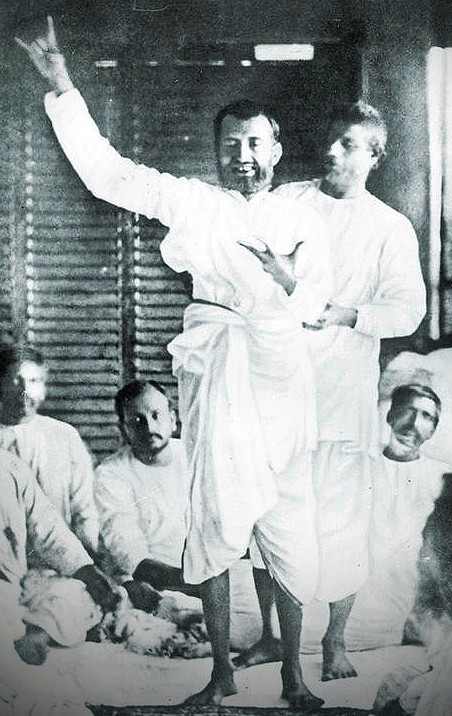|
Bhava
The Sanskrit word bhava (भव) means being, worldly existence, becoming, birth, be, production, origin,Monier Monier-Williams (1899), Sanskrit English Dictionary, Oxford University Press, Archiveभव bhava but also habitual or emotional tendencies. In Buddhism, ''bhava'' is the tenth of the twelve links of '' Pratītyasamutpāda''. It is the link between the defilements, and repeated birth, that is, reincarnation. In Thai Buddhism, ''bhava'' is also interpreted as habitual or emotional tendencies which leads to the arising of the sense of self, as a mental phenomenon. In Buddhism In Buddhism, ''bhava'' (not ''bhāva'', condition, nature) means being, worldly existence, becoming, birth, be, production, origin experience, in the sense of rebirths and redeaths, because a being is so conditioned and propelled by the karmic accumulations; but also habitual or emotional tendencies. [...More Info...] [...Related Items...] OR: [Wikipedia] [Google] [Baidu] |
Bhava Samadhi
Bhava Samadhi is a state of ecstatic consciousness that can sometimes be a seemingly spontaneous experience, but is recognized generally to be the culmination of long periods of devotional practices. It is believed by some groups to be evoked through the presence of "higher beings." "Bhava" means "feeling", "emotion", "mood", "mental attitude" or "devotional state of mind." "Samadhi" is a state of consciousness in which the mind becomes completely still (one-pointed or concentrated) and the consciousness of the experiencing subject becomes one with the experienced object. Thus, "''bhava samadhi''" denotes an advanced spiritual state in which the emotions of the mind are channelled into one-pointed concentration and the practitioner experiences devotional ecstasy. ''Bhava samadhi'' has been experienced by notable figures in Indian spiritual history, including Sri Ramakrishna Paramahamsa and some of his disciples, Chaitanya Mahaprabhu and his chief disciple Nityananda, Mirabai, Kun ... [...More Info...] [...Related Items...] OR: [Wikipedia] [Google] [Baidu] |
Bhavacakra
The bhavacakra (Sanskrit: भवचक्र; Pāli: ''bhavacakka''; Tibetan: སྲིད་པའི་འཁོར་ལོ, Wylie: ''srid pa'i 'khor lo'') is a symbolic representation of saṃsāra (or cyclic existence). It is found on the outside walls of Tibetan Buddhist temples and monasteries in the Indo-Tibetan region, to help non Buddhists understand Buddhist teachings. It is used in Indian Buddhism and Tibetan Buddhism. Etymology ''Bhavachakra'', "wheel of life," consists of the words ''bhava'' and ''cakra''. ''bhava'' () means "being, worldly existence, becoming, birth, being, production, origin".Monier Monier-Williams (1899), Sanskrit English Dictionary, Oxford University Press, Archiveभव bhava In Buddhism, ''bhava'' denotes the continuity of becoming (reincarnating) in one of the realms of existence, in the samsaric context of rebirth, life and the maturation arising therefrom. It is the tenth of the Twelve Nidanas, in its '' Pratītyasamutpāda'' doctrine. ... [...More Info...] [...Related Items...] OR: [Wikipedia] [Google] [Baidu] |
Pratītyasamutpāda
''Pratītyasamutpāda'' (Sanskrit: प्रतीत्यसमुत्पाद, Pāli: ''paṭiccasamuppāda''), commonly translated as dependent origination, or dependent arising, is a key doctrine in Buddhism shared by all schools of Buddhism. It states that all dharmas (phenomena) arise in dependence upon other dharmas: "if this exists, that exists; if this ceases to exist, that also ceases to exist". The basic principle is that all things (dharmas, phenomena, principles) arise in dependence upon other things. The doctrine includes depictions of the arising of suffering (''anuloma-paṭiccasamuppāda'', "with the grain", forward conditionality) and depictions of how the chain can be reversed (''paṭiloma-paṭiccasamuppāda'', "against the grain", reverse conditionality).Fuller, Paul (2004). ''The Notion of Ditthi in Theravada Buddhism: The Point of View.'' p. 65. Routledge.Harvey, Peter. ''The Conditioned Co-arising of Mental and Bodily Processes within Life and Bet ... [...More Info...] [...Related Items...] OR: [Wikipedia] [Google] [Baidu] |
Rebirth (Buddhism)
Rebirth in Buddhism refers to the teaching that the actions of a sentient being lead to a new existence after death, in an endless cycle called '' saṃsāra''. This cycle is considered to be '' dukkha'', unsatisfactory and painful. The cycle stops only if moksha (liberation) is achieved by insight and the extinguishing of craving. Rebirth is one of the foundational doctrines of Buddhism, along with karma, Nirvana and liberation. Rebirth was however less relevant among early Buddhist teachings, which also mentioned the beliefs in an afterlife, ancestor worship, and related rites. The concept varies among different Buddhist traditions. The rebirth doctrine, sometimes referred to as reincarnation or transmigration, asserts that rebirth takes place in one of the six realms of samsara, the realms of gods, demi-gods, humans, the animal realm, the ghost realm and hell realms. Rebirth, as stated by various Buddhist traditions, is determined by karma, with good realms favored by ''kush ... [...More Info...] [...Related Items...] OR: [Wikipedia] [Google] [Baidu] |



